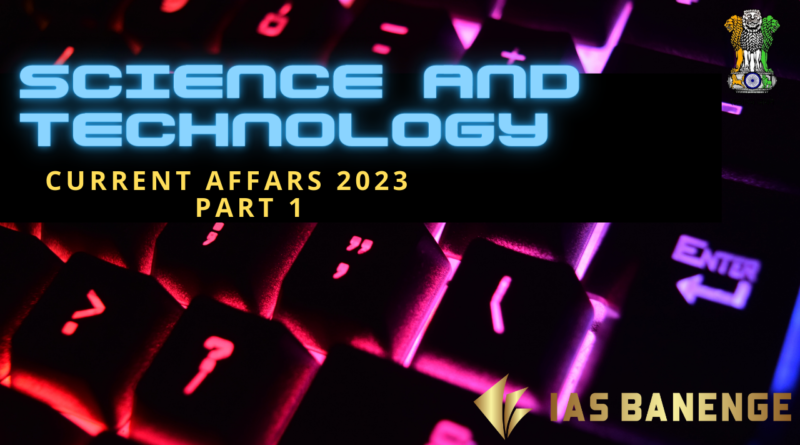Science & Technology Current Affairs for UPSC 2023 I PART -1
BIOTECHNOLOGY
1.GENETIC MODIFICATION (GM) TECHNOLOGY
Genetic Modification (GM) technology, also known as genetic engineering or biotechnology, refers to the process of altering the DNA or genetic makeup of an organism to achieve a desired trait or characteristic. This technology has become increasingly important in the fields of agriculture, medicine, and biotechnology, with the potential to revolutionize how we produce food, treat diseases, and develop new materials.
The basic process of genetic modification involves the introduction of new genetic material into an organism’s DNA, which can be done in a number of ways. One common method is to use a “vector,” such as a virus or a plasmid, to deliver the new genetic material into the target organism’s cells. Another method involves using gene-editing techniques like CRISPR/Cas9 to precisely modify specific genes within an organism’s DNA.
The potential benefits of GM technology are vast. In agriculture, genetically modified crops can be engineered to be more resistant to pests, diseases, and environmental stressors like drought or extreme temperatures, leading to increased crop yields and more efficient use of land and resources. In medicine, GM technology can be used to develop new treatments and cures for diseases by modifying the genetic material of cells within the body. It can also be used to create new materials with unique properties, such as bacteria that produce biodegradable plastics.
However, there are also concerns about the potential risks and unintended consequences of GM technology. For example, there is concern that genetically modified organisms (GMOs) could escape into the wild and disrupt natural ecosystems. There is also concern about the potential for GMOs to crossbreed with non-GMO organisms and create hybrid organisms with unknown characteristics.
Another concern is the potential impact of GM technology on human health. While genetically modified foods have been deemed safe for human consumption by many regulatory agencies, there are concerns that they could cause allergic reactions or other health problems in some people. There is also concern that the widespread use of GM crops could lead to the development of “superweeds” that are resistant to herbicides and other chemical treatments.
In conclusion, genetic modification technology has the potential to bring about significant benefits in various fields. However, it is important to carefully consider the potential risks and unintended consequences of this technology and to ensure that appropriate regulations and safeguards are in place to protect human health and the environment.
2. GENOME EDITING
“DBT Eases Norms for Research into Genetically Modified Crops with New Guidelines for Safety Assessment of Genome Edited Plants 2022”
The Ministry of Environment, Forest and Climate Change has issued guidelines for the safety assessment of Genome Edited Plants, which provide a regulatory framework and scientific guidance for the development of such plants using site-directed nucleases. Researchers using gene-editing technology to modify plant genomes are exempted from seeking approvals from the Genetic Engineering Appraisal Committee, except for clauses requiring GEAC permission. The guidelines are expected to accelerate genetic improvement of crops, increasing farmer’s income, and providing a roadmap for sustainable use of genome editing. In contrast to genome editing, transgenic technology involves the introduction of foreign DNA sequences into an organism. Various bodies such as the Recombinant DNA Advisory Committee, Institutional Biosafety Committee, and Review Committee on Genetic Manipulation are responsible for regulating GM crops in India. Recently, GEAC recommended the environmental release of transgenic hybrid mustard, while the Haryana government issued NOC to conduct field trials on BG-2 RRF, a herbicide-tolerant and insect-resistant variety of BT cotton.
3.SITE-DIRECTED NUCLEASE (SDN) TECHNOLOGY
“Department of Biotechnology releases revised guidelines for genome edited plants using Site-directed nucleases (SDN)”
Site-directed nucleases (SDN) or sequence specific nucleases (SSN) is a technology used for genome editing by cleaving DNA strands at specific sites. This technology uses targeted DNA breaks and the host’s natural repair mechanisms to introduce small changes in the DNA. Zinc-Finger Nucleases (ZFNs) and Transcription Activator Like Effector Nucleases (TALENs) are the main SDN technologies used. The editing process is categorized into three categories: SDN 1, SDN 2, and SDN 3. SDN-1 and SDN-2 do not involve foreign genetic material and result in plant varieties that are indistinguishable from conventionally bred crops. These varieties do not fall under the scope of GMO legislation. However, in SDN-3, if foreign DNA exceeding 20 base pairs is inserted, the resulting plant variety falls under GMO legislation.
4. CRISPR-CAS 9
“10-Year Anniversary of CRISPR-Cas9 Gene Editing Pioneered by Charpentier and Doudna, Nobel Prize Winners”
CRISPR-Cas9 is a genetic tool used for gene editing, which was originally found in bacteria. Bacteria use the CRISPR sequence to remember and protect themselves from specific viruses that attack them. CRISPR-associated protein 9 (Cas9) is an enzyme that can be guided by a piece of RNA to locate and snip out a specific gene, and then replace it with a desired piece of DNA. However, the use of CRISPR-Cas9 also raises ethical concerns, particularly with regards to “designer babies,” as well as ecological impacts. In India, researchers have used CRISPR-Cas9 for a variety of applications, such as treating sickle cell anemia and improving the nutritional quality and pathogen resistance of bananas through genome editing.
5.CHIMERIC ANTIGEN RECEPTOR T (CAR-T) CELL THERAPY
“Indigenously Developed CAR-T Therapy Tested on Patients in India for the First Time by IIT Bombay and Tata Memorial Centre”
The National Biopharma Mission (NBM), funded by the Biotechnology Industry Research Assistance Council (BIRAC), has supported the development of India’s first indigenously developed CAR-T therapy for cancer treatment. BIRAC is a Public Sector Enterprise established by the Department of Biotechnology as an Interface Agency to promote emerging biotech enterprises.
CAR-T therapy is a type of cancer treatment that involves modifying T cells from the patient’s blood by adding a gene for a man-made receptor called CAR. This receptor is designed to bind to specific proteins on cancer cells, making it easier for T cells to identify and attack them. The modified T cells, called CAR-T cells, are then administered back to the patient.
CAR-T therapy holds the potential for curing certain types of cancers and has several benefits over traditional treatments like chemotherapy. It is administered only once, requires short treatment time, and results in more rapid recovery.
6.GENOME SEQUENCING
In a recently published research, an international team described the first-ever sequencing of a complete human genome.
Genome sequencing is the process of determining the complete DNA sequence of an organism’s genome. This involves identifying the order of nucleotides (adenine, guanine, cytosine, and thymine) that make up an individual’s genetic code. The human genome contains approximately 3 billion base pairs, and advancements in technology have made it possible to sequence entire genomes in a relatively short amount of time and at a lower cost than ever before.
Genome sequencing has numerous applications in research, medicine, and agriculture. In research, it can be used to identify genetic variations that cause or contribute to diseases, develop new therapies, and understand the evolutionary history of species. In medicine, genome sequencing can be used to diagnose rare genetic disorders, predict disease susceptibility, and personalize treatment plans based on an individual’s genetic makeup. In agriculture, genome sequencing can be used to improve crop yields and develop disease-resistant plants.
There are two main types of genome sequencing: whole-genome sequencing and targeted sequencing. Whole-genome sequencing involves sequencing an entire genome, while targeted sequencing focuses on specific regions of the genome. Targeted sequencing is often used in medical applications, where specific genes or regions of the genome are known to be associated with certain diseases.
While genome sequencing has revolutionized the field of genetics, it also raises important ethical, legal, and social issues. These include concerns over privacy, the potential misuse of genetic information, and the impact of genetic testing on individuals and society.
Despite these challenges, genome sequencing continues to advance and is expected to play an increasingly important role in a wide range of fields, from medicine to conservation biology. As technology continues to improve and costs decrease, it is likely that genome sequencing will become even more widespread and accessible in the years to come.
7. GENOMIC SURVEILLANCE
“Building a Sustainable System for Genomic Surveillance to Combat Outbreaks of Pathogens and Variants, Including COVID-19 and Monkeypox”
Genomic surveillance is the practice of monitoring the genetic makeup of pathogens, such as viruses and bacteria, to track their spread and evolution over time. This involves sequencing the genomes of these pathogens and analyzing the data to identify changes or mutations that may affect their virulence or transmissibility.
Genomic surveillance has become increasingly important in recent years as outbreaks of infectious diseases, including COVID-19, monkeypox, and others, continue to occur around the world. By monitoring the genetic makeup of these pathogens, scientists can better understand how they are spreading and evolving, and develop strategies to control their spread.
Genomic surveillance involves collecting samples of the pathogen from infected individuals, sequencing the genome of the pathogen, and comparing it to other genomes from around the world. This allows scientists to track the spread of the pathogen and identify any mutations that may be increasing its ability to infect or harm individuals.
In addition to tracking the spread of infectious diseases, genomic surveillance has numerous other applications, including monitoring the emergence of drug-resistant pathogens, identifying outbreaks of foodborne illnesses, and tracking the spread of invasive species.
Overall, genomic surveillance is a critical tool in the fight against infectious diseases, allowing scientists to better understand how pathogens are spreading and evolving, and develop strategies to control their spread.
8.CLONING
“China Clones Wild Arctic Wolf for the First Time in History”
Cloning is the process of producing genetically identical copies of biological entities. Clones have the same genetic makeup as the original, but may not always look identical due to environmental factors. In mammals, identical twins are natural clones.
There are three types of artificial cloning:
- Gene/DNA cloning,
- Reproductive cloning
- Therapeutic cloning.
Reproductive cloning involves transferring nuclear material from a somatic cell into an enucleated egg cell, which is then stimulated to divide and form an embryo with the same genome as the nuclear donor. This process was used to create Dolly sheep, the first mammal cloned. Therapeutic cloning is similar to reproductive cloning, but the produced embryo is grown in a laboratory.
9. INDIAN BIOLOGICAL DATA CENTER
Indian Biological Data Center (IBDC) was inaugurated at Faridabad, Haryana.
The Regional Centre of Biotechnology in collaboration with the National Informatics Centre has established the first national repository for life science data in India. The repository, called the Indian Biological Data Centre (IBDC), is mandated to archive all life science data generated from publicly-funded research in India as per the Biotech-PRIDE guidelines. The data will be stored on a four-petabyte supercomputer called ‘Brahm’ and will follow the FAIR principle for data sharing. The IBDC contains genomes sequenced by the Indian Sars-CoV-2 Genomic Consortium (INSACOG) and currently has two sections – Indian Nucleotide Data Archive (INDA) and Indian Nucleotide Data Archive – Controlled Access (INDA-CA). The IBDC offers open access/time-release access and restricted access to its data.
Maharashtra Cabinet approved the Gene Bank Project
| Project | Description |
|---|---|
| Gene Bank Project | A type of biorepository to preserve plants (by collecting seeds, plants, tissue cultures) and animals (by collecting sperm and eggs). |
| National Gene Bank | Located at National Bureau of Plant Genetic Resources, Pusa. It is the world’s 2nd largest refurbished gene bank. |
| National Animal Gene Bank | Located at National Bureau of Animal Genetic Resources, Karnal. |
| Indian Seed Vault | Located at Chang La in Ladakh. |
TO THE POINT
- Department of Biotechnology has developed BioRRAP to track the regulatory approvals for a research proposal on a single portal.BioRRAP provides a single route to direct applicants to regulatory agencies that provide the required approvals for biological research. The BioRRAP ID generated through this portal is linked with the portals of various regulatory agencies, providing credibility to biological research and strengthening interdepartmental synergies. This is expected to increase the efficacy in the functioning of agencies regulating various aspects of biological research.
- Scientists have built a molecular-scale motor using the DNA origami method (involves folding of DNA to create 2D and 3D objects at nanoscale).Molecular motors are proteins that convert chemical energy into mechanical work to drive intracellular movements. They play important roles in various biological processes, such as muscle contraction and cell division (mitosis). These motors enable cells to move organelles, transport molecules, and generate forces for cell movement, among other functions. Understanding the mechanisms of molecular motors can provide insights into the fundamental principles of biology and can also have potential applications in medicine and technology.




